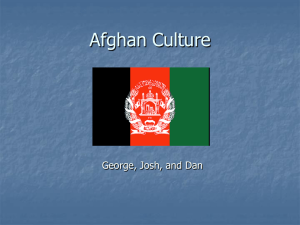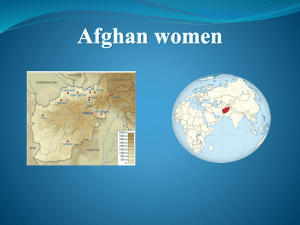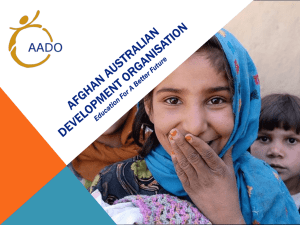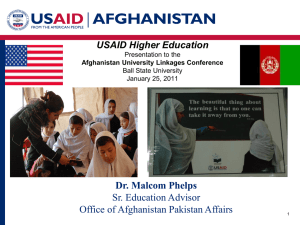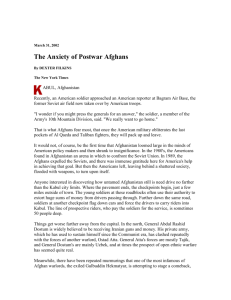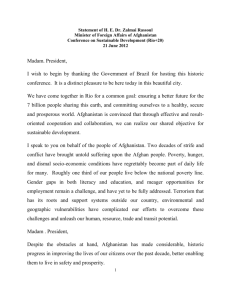An Introduction to Afghanistan Culture
advertisement
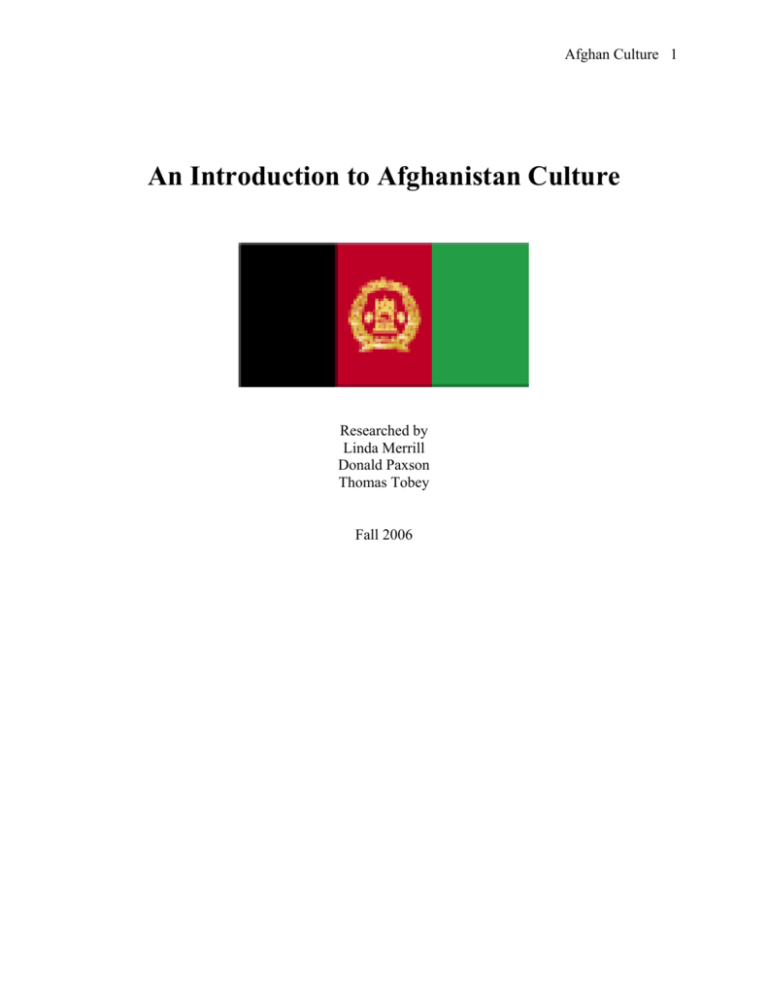
Afghan Culture 1 An Introduction to Afghanistan Culture Researched by Linda Merrill Donald Paxson Thomas Tobey Fall 2006 Afghan Culture 2 Brief History • • • • Afghanistan's crossroads position in Central Asia has subjected it to constant invasion and conquest throughout its long recorded history. The history of Afghanistan is a history of war and conflict even up to present day. The Arabs introduced Islam in the 7th century and the Turks briefly made Afghanistan the center of Islamic power and civilization at the beginning of the 11th century. In 1747, the Pashtun, the dominant ethnic group in Afghanistan, established their dynasty in the eastern and southern portions of the country. By the early 1900’s, the Pashtuns had effective physical control over all of Afghanistan. Although many countries over the years have tried to take over Afghanistan, mainly Great Britain and Russia, none were ever successful. Because of this, Afghans pride themselves on their country’s independent heritage. Afghanistan Demographics • Population of 28,513,677 (July 2004 est.). More than 3.5 million Afghans live outside the country, mainly in Pakistan and Iran, although over two and a half million have returned since the removal of the Taliban. American Afghanistan Demographics • Number of persons Born in Afghanistan and now living in the United States as reported by the 2000 census. 45195 172 • United States Maine Number of people who report Afghanistan Heritage that are living in the United States as reported by the 2000 census. 52,107 235 United States Maine Afghan Holiday Celebrations: As reported by, The Afghans Their History and Culture. • The most festive holiday celebrated by Afghans, and Iranians, is Nawroz, the New Year celebration, which occurs on March 21, the vernal equinox. Literally meaning ‘new day,’ Nawroz is celebrated with picnics, similar to our cookouts. The festival has its roots in Zoroastrianism, a religion brought from Persia long before the rise of Islam. During the celebrations, lavish meals are prepared. Two dishes, samanak and haft-mehwah are specially cooked for the occasion. Samanak is a dessert made of wheat and sugar that can take two days to prepare. Haft-mehwah consists of seven fruits and nuts that symbolize the coming of spring. Afghan Culture 3 • As Muslims, Afghans celebrate Muslim holidays. The two most important holidays are ‘Eid al Fitr and 'Eid-al-Qurban. ‘Eid al Fitr marks the end of Ramadan, the month of ritual fasting associated with the lunar calendar. These holidays occur eleven or twelve days earlier each year, according to the Arabic lunar calendar, which is eleven or twelve days shorter than our solar calendar. Muslim communities in the United States celebrate these holidays in various ways, and Afghan refugees have no trouble in managing satisfactory celebrations. • ‘Eid-e-Qurban, also known as ‘Eid-al-Adha, marks the preparation for hajj, which takes place during the 12th month of the Muslim calendar, between the 7th and 10th days. ‘Eide-Qurban is celebrated on the 10th day and centers on the ritual slaughter of a sheep or goat to commemorate Abraham’s sacrificial slaying of a sheep instead of his son Isaac. The family uses one-third of the slaughtered animal; another third by relatives and the rest is given to the poor. Friends also exchange presents during this time. Afghanistan Holidays for 2006 include: January-8 February-9 March-21 April-11 April-28 May-1 May-4 August-19 August-30 October-24 Arafa Ashura (Martyrdom of Imam Hussain) Nawroz (New Year's Day ) Mouloud (Birth of the Prophet) Formation of the Islamic State's Victory Worker's Day Remembrance Day for Martyrs & Disabled Independence Day Children's Day Id al Fitr (End of Ramadan) Muslim Holidays for 2006 include: January-11 February-9 April-10 August-21 October-19 Id al Adha (Feast of the Sacrifice) Ashoura Mawlid an-Nabi Lailat - Ul - Isra' Wal Mi'raj (The Prophet's Night Journey to Jerusalem & Ascension) Lailat - Ul - Qadr Afghan Culture 4 Religion • • • • The predominate religion in Afghanistan is Islam which 99% of the population follow. A follower of Islam is referred to as a Muslim. Friday is the Muslim holy day. Most shops and offices will be closed. Government offices and businesses may also close on Thursday, making the weekend Thursday and Friday. The Afghan Muslim population is divided into two denomination Sunni and Shia. Sunni • • • • • Sunni Muslims are approximately 85% of the Afghan Muslim population. They represent a branch of Islam that came through the khalifah, which started with Abu Bakr, who was the first Muslim ruler after the Prophet Muhammad. The Sunni Muslim accepts Abu Bakr as a righteous and rightful khaliph. The Sunnis use the term Imaam synonymously with the term khalifah. A khalifah may be elected, or nominated by his predecessor, or selected by a committee, or may acquire power through military force. A khalifah need not be sinless. It is lawful for a person of inferior qualities to be made a khalifah while persons of superior qualities are present. Shi'a • • • • • Shi'a makes up 14% of the Afghan Muslim population. Shi'a Muslims adhere to what they consider the teachings of the Prophet Muhammad and the religious guidance of his family whom they refer to as the Ahlul Bayt. Shi'as consider the first three ruling khaliphs of Islam a historic occurrence and not something attached to faith. Shi'a Muslims believe that the prophet had appointed his son-in-law Ali ibn Abi Talib as his successor. Only the Shiahs believe in the institution of Imaamah. Literally, "imaam" means a leader. In Shiah belief, an Imaam is the person appointed by God and introduced by the Prophet and then by each preceding Imaam by explicit designation to lead the Muslim community, interprets and protects the religion and the law, and guides the community in all affairs. Mullahs • • An important figure in Muslim life is the mullah (a male religious leader or teacher). Any man who can recite the Qur’an (Koran), the sacred scripture of Islam, from memory can be a mullah. In Afghanistan, however, the mullah may not understand either the words or the meaning because the book was written and is memorized in Arabic, which is not a local language. A mullah conducts the Friday sermon and prayers, marriages, and funerals. Afghan Culture 5 • Mullahs arbitrate local disputes, based upon Islamic legal principles, and they are also called upon to provide advice and resolution of many other physical, social, and personal problems, including such things as medicines, local water disputes, or a family feud. The Five Pillars of Islam 1. Shahadah, to testify that there is none worthy of worship except God and I testify that Muhammad is the Messenger of God. 2. Salat, the requirement to pray five times a day at fixed times. 3. Zakat, alms-giving, is giving charity to the poor and needy by able Muslims, based on the wealth that one has accumulated. 4. Sawm, or fasting, is an obligatory act during the month of Ramadan. 5. The Hajj is a pilgrimage that occurs during the month of Dhu al-Hijjah to the city of Mecca. Every able-bodied Muslim who can afford to do so is obliged to make the pilgrimage to Mecca at least once in his or her lifetime. Ramzan • • • • • The ninth month of the Islamic (lunar) calendar is the holy month of Ramadan or Ramzan in several countries. It is considered the most venerated, blessed and spiritually-beneficial month of the Islamic year. Prayers, fasting, charity, and self-accountability are especially stressed at this time. Muslims believe that the Qur'an was sent down to the earth during this month. Suhoor is a light meal or snack before dawn that children and the elderly may have. In addition to fasting, Muslims are encouraged to read the entire Qur'an which is called Tarawih. Islamic calendar Islamic holy days fall on fixed dates of the lunar calendar, which means that they occur in different seasons in different years in the Gregorian calendar. Afghan Ethnic Groups • • • Major Ethnic Divisions: Pashtun 52%, Tajik 25%, Uzbek 6%, Hazara 12%, Other 5%; Minor Ethnic Division: Chahar Aimaqs, Turkmen, and Baloch. Religious Affiliations: Sunni Muslim 84%, Shi'a Muslim 15%, other (Hindu, Jewish, Christians) 1%. • Pashtun • • The Pashtun are the dominant ethnic group in Afghanistan and account for over half of the population. They are divided into tribal and sub-tribal groups to which they remain loyal. Afghan Culture 6 • • • These tribal divisions have been the source of conflict among Pashtuns throughout their history. Pushtun cultural centers tend to be in the eastern and southern portions of the country. Most speak Pashtu and are mostly Sunni Muslims. • Tajik • The Tijiks are considered Afghanistan’s educated elite and tend to be wealthy. • Although Tajiks hold significant political influence and power, they are not the dominant group in Afghanistan. • Tajiks are mostly Sunni Muslims, speak Persian and live predominantly in the northeastern and western part of the country. • Uzbek • Descended from the Central Asian Turks who frequently invaded from the north. • Many Uzbeks fled into northern Afghanistan in the 1920s to escape the suppression when the Soviet government was trying to stamp out their customs and Moslem religion. • The most populace Turkish group in Afghanistan. • Hazara • Speak Farsi and are mostly Shi'i Muslims, yet there are also some Sunni Muslim Hazaras. • Hazaras are the most economically deprived group in Afghan culture and have much less status than other Afghan ethnic groups. • Forced by the controlling Pashtuns to live in the barren mountains of central Afghanistan. Beliefs About Time Usage: Work • The type of work that people engage in is divided along ethnic and regional lines in Afghanistan. • • • • Pashtuns are generally merchants, traders, farmers, and animal breeders. Tajiks are town- dwelling traders, skilled artisans, farmers and herders. Many Tajiks are prosperous enough to be regarded as middle and upper class citizens. Uzbeks are farmers and stockmen, breeding the karakul sheep and an excellent type of Turkman horse. Hazaras occupy the lowest socioeconomic bracket in Afghanistan. They are generally very poor and practice subsistent farming and herding. Afghan Culture 7 The Family Afghanistan people have strong values, beliefs and rules surrounding the family and its member’s behavior. Additionally families are highly dependant upon one another to meet many aspects of everyday life. Family roles are complex and they change depending upon ethnicity and region. The family remains the single most important institution in Afghan society. Characteristically, the Afghan family is endogamous (with parallel and cross-cousin marriages preferred), patriarchal (authority vested in male elders), patrilineal (inheritance through the male line), and patrilocal (girl moves to husband's place of residence on marriage). Polygyny (multiple wives) is permitted, but is no longer so widely practiced. Traditional Family Roles • • • • • • • • • • • • Afgan families have a high regard for age, as well as a reverence for motherhood. The extended family serves as a support system, economically and socially. Child socialization takes place within the family because of deficiencies in the education system. Extended family households may contain three to four generations including the male head of family and his wife, his brothers, several sons and their families, cousins with their families, as well as all unmarried and widowed female, and elderly grandparents. These multigenerational units practice close economic cooperation and come together on all life-crisis occasions. This permits cohesive in-group solidarity to be maintained. The senior woman is responsible for delegating domestic responsibilities. When families include plural wives, each wife has her own room, with her own belongings and furnishings; sometimes her own cooking space is provided. The courtyard provides space for joint household activities and entertainment. The women of the households work together to care for and discipline the children. The senior active male member, typically the grandfather, controls all expenditures. Adults work very hard but also do extensive visiting or entertaining during weekends and sometimes on weekday nights as well. Women are responsible for most of the domestic work of the house, cooking, cleaning, entertaining and socializing children. An Afghan's family is sacrosanct and a matter of great privacy. It is considered a breach of manners among liberal Afghans, and an act requiring revenge among conservatives, for a man to express interest of any sort in another man's female relatives. It is this cultural sense of privacy that probably was reinterpreted by the Taliban into an insistence that women be covered from head to foot when in public: A woman belongs to her family and should not be available, in any sense, to outsiders. In the rural areas, interrelated responsibilities between men and women establish a bond of partnership that builds mutual respect. Carpet making is an example. The men herd and shear the sheep, the women spin the wool, the men dye the wool, the women weave the carpet, and the men market the product. A woman, often an elderly member of the household, receives the household's supply of grain following the harvest. She must make sure that this supply of the family's basic food staple is apportioned correctly over the year until the next harvest comes in. Otherwise, the family must go into debt, or starve. Afghan Culture 8 • • • • • The male has the right to make decisions that control female behavior and it is done to preserve male prestige and family honor. Women’s independence is not encouraged and the families’ social standing may suffer if the women do not remain dependant and submissive to her husbands rules. Women derive a certain amount of advantage within family relationships from their ability to damage family prestige through subtle nonconformist behavior, such as simply failing to provide adequate hospitality, or a lack of honor within the home. The selection of mates is important to building a stronger family and it requires a multiplicity of considerations, including strengthening group solidarity, sustaining social order, confirming social status, enhancing wealth and power or economic and political standing, increasing control over resources, resolving disputes, and compensating for injury and death. Within this complicated web governing marriage negotiations, other factors must also be taken into account such as sectarian membership, ethnic group, family status, kin relationships, and economic benefits. The bride's skills, industriousness and temperament are also considered and, with all, the happiness and welfare of the girl is often not neglected. The Afghan Family in the United States • • • • • • • • • • In the United States, family life is still the core of Afghan culture and psychological wellbeing. Afghans mainly socialize with extended family members. This family focus can cause culture conflict in the United States. Extended family obligations, especially to parents and older siblings, often supersede other responsibilities, including allegiance to one's spouse, one's job, and certainly to one's own needs. In most Afghan American families, traditional role relationships have been disturbed. Although traditional Islamic cultures view the woman's proper place as in the home, many Afghan women must work outside the home to contribute to the family income. Afghan women have adapted to the United States better than have men, who have had difficulty finding a middle road between a traditional and an American lifestyle. Husbands whose wives earn salaries and have economic freedom suffer a loss of paternal leadership as the family’s sole breadwinner. The traditional husband’s power and role as head of the family is further damaged when children learn English more quickly than the parents do and become their parents’ translators and spokespersons. Children learn independence and assertiveness in school settings, which contradict cultural family values. Families may worry that children will pick up immodest behavior from their non-Muslim classmates. Children are expected to work hard in school and to come home after school to do homework; strict parents do not allow their children to engage in after-school activities. In the United States, Afghans perceive school and social service agency intervention as undermining an intrusive upon parental authority, responsibility and control, even demeaning marriage, the purpose of which is to bear and raise children. Divorce is rare but it is becoming more common with acculturation. Afghan Culture 9 Dress • • • • • • • • • • • The term hijab or veil is not used in the Qur'an to refer to an article of clothing for women or men, rather it refers to a spatial curtain that divides or provides privacy. Afghan women typically wear a two-piece outfit consisting of loose trousers worn under a tunic or a kurta with a high neck and long sleeves. Many women complete the outfit with a long scarf that covers the head when modesty is required, but is at other times gracefully draped across the shoulders, called the hijab. Some women wear a chador, a garment that completely covers the head, shoulders, and face except for the eyes. Girls under the age of twelve do not wear chadors nor do women wear them when they are at home among their own families. A burkha is an all-enveloping outer garment worn over the usual daily clothing and removed when the woman returns to the sanctuary of the household. In the United States, Afghans usually adopt Western clothing styles, although in the summer they might wear their native dress, as it is better adapted to hot weather than Western clothes are. Women are comfortable in slacks and tunic-like tops and sweaters. Afghan men also wear a long tunic over baggy trousers and often wear a vest over the tunic. Turbans, traditionally white but now of any color, are wound around the locally favored type of turban caps. Pashtuns and others who imitate them leave a couple of feet of turban cloth hanging down. The pakul is a soft, round-topped Afghan men's hat, typically of wool. The hat is worn by Pashtun. The purpose of the hat is to help a Sunni man pray, the forehead touches the ground, and the round bit provides a cushion. Karakul is a hat made from the wool of Karakul sheep. Prominent Muslim men in Central Asia wear it. Food • • • • • • Afghan food centers on rice dishes called pilaus. Qabile pilau, typically pieces of lamb are covered with a pilau that includes strips of carrots and currants Aushak, scallion-filled dumplings with meat sauce and yogurt, sprinkled with mint. Boiled curd is often eaten for breakfast. In rural Afghanistan, regular midday meals are not eaten, but people carry around nuts and dried fruit for energy throughout the day. The usual beverage is tea, which constitutes one of Afghanistan’s major imports. Dining Etiquette • • • Always remove your shoes at the door if visiting a home. If eating at someone’s home, you will be seated on the floor, usually on cushions called toshak. Wait to be shown where to sit. Afghan Culture 10 • • • • • • • If you can, sit cross-legged. Otherwise, sit as comfortably as you can. Do not sit with legs outstretched and your feet facing people. Because hands are used in, eating there is a hand washing ceremony before meals and for this a special bowl and jug called a haftawa-wa-lagan is used. A young boy or girl member of the family brings this to the guest, and pours the water over his hands for him, the bowl being used to catch the water. Food is generally served communally and everyone will share from the same dish. Do not eat with the left hand. Always pass and receive things using your right hand too. Food is eaten with the hands. It will be a case of watch and learn. Food is usually scooped up into a ball at the tip of the fingers, and then eaten. Leave food on your plate otherwise it will keep being filled up again. Beliefs About Time Usage: Play & Leisure Leisure • • • • Afghan culture is rich in social customs. Afghans tend to be very social and ties among families and friends are very strong. Drinking tea together is a very common social custom. Often people meet at homes or shops to enjoy tea and socialize. Afghans are very generous people. Guests in even the poorest of Afghan homes are expected to eat and lodge with their hosts. For the families that can afford it, they build “Ojras” for guests. This is a separate guest home. Afghans believe in making their guest feel as comfortable as possible while visiting. Play • Afghans are very fond of sports and games as they provide a refuge from the daily turmoil in Afghanistan. • Buzkashi • Means “grab the goat”. • It is an ancient game played in Afghanistan of which the Uzbeks are considered the champions. • It is played on horseback by teams of 10 men. • The point of the game is to pick-up, carry a dead calf carcass through the opposing team (armed with whips), and go a ½ mile to a “goal point” to score and back. Pahlwani • This is a very popular sport and is much like an American style wrestling match. • Afghan Culture 11 • • • The goal of the game is to pin your opponent to the ground without touching his legs. Gursai • This game played amongst children and the players hold their left foot in their right hand and then hop around trying to knock each other to the ground. Fighter-kites • This is a very competitive pastime in Afghanistan and is a source of great pride for the winners. • Afghan men play the game. • The kites have elaborate designs and are made of tissue paper and bamboo. • The point of the competition is to cut down each other’s kites and the last kite in the sky wins. Beliefs About Health and Illness: Folk Beliefs, Healing and Wellness • Afghans believe that good health is influenced and maintained through daily exercise, a balanced diet and sufficient rest. Additionally, Afghans believe that health and illness are manifested in 3 distinct ways: Religious Beliefs • • • • Illness and healing are viewed as being gods will. Illness can be healed through reading the Koran. Relevant verses from the Koran are written down and carried around by the sick. Following the precepts of Islam that emphasize personal hygiene, prevent natural illness. Traditional Western Medicine • • Health and illness are approached using traditional western medicine practices. Care is administered through university trained healthcare professionals. Traditional Afghan Medicine • • • • • This is a cultural based approach to health and illness in which traditional Afghan methods of treating illness are used. Composed of knowledge handed down through families over time. This form of care incorporates herbs, tea, and medicinal plants. In this model, a “hakim” administers care and is considered a traditional doctor. There is an Afghan belief that treatment of illness relates to temperature of food and beverage. For example, consuming food or drink that is cold would by contrast reduce a fever. Afghan Culture 12 Important Concepts Related to the Care of Afghans Common Forms of Physical and Mental Illnesses • • • • Most common aliments seen in refuges to the U.S. from Afghanistan are caused by malnutrition and include diarrhea, acute respiratory infection, and measles. Of Afghan refugees, 41% had dental caries, 39% had dermatologic disorders, 36% had intestinal parasites, 23% had gastro-intestinal disorders, and 12% had joint and back pain. Afghan-Americans that have been in the U.S. longer tend to have high rates of heart disease and mental health related problems. There is a high incidence of posttraumatic stress syndrome in Afghan refuges due to witnessing the loss of family and homes in Afghanistan. Challenges to Consider for Healthcare Providers • • • • • • • • Afghans see family matters as strictly private. People are generally reluctant to share personal and family issues with non-family members, including health care professionals, though women may discuss their problems with friends, including non-Afghans. Many Afghans are skeptical of the U.S. healthcare system and its technology. Afghans value a more humanistic approach to health care as well as hands-on evaluation and diagnosis by trained medical professionals. Paramount to providing care to Afghans is the understanding that they value modesty and respect. This means that health care professionals must ask for permission to engage in physical contact. Additionally, health care professionals should be open and forthcoming in all aspects of treatment. Practitioners should be aware of certain Islamic practices such as female circumcision Afghan refugees can suffer from cultural shock due to change in family roles, cultural isolation, and change in social status. All healthcare treatment should be conservative in nature to match the Afghan value for modesty. Gender issues that apply to the medical treatment of Afghans include being aware that certain female medical issues may call for treatment by female practitioners only. Afghan Culture 13 Relevant Afghan Cultural Etiquette for Healthcare Professionals • • • • • • • In greeting, women should wait for Afghan men to offer their hand before shaking. Titles are preferred to the use of first names. When entering an Afghan client’s home, one should always remove their shoes and be careful not to walk on prayer mats. Before engaging an Afghan in the purpose of his or her medical visit, it is useful to initiate the visit with casual conversation. In doing so, male practitioners should not inquire about the welfare of a wife or daughter. Avoid use of left hand in conversational gesturing or shaking hands and do not point or use the “thumbs-up” symbol. Always respect an Afghan’s space. Knock when entering their homes, as well as hospital or examination rooms. The term “Afghani” relates to money and is insulting when used to describe the Afghanistan’s Ethnicity. Afghan is the correct term for describing ethnicity. Afghan Culture 14 References Abid M.U. (n.d.) Future of Pashto, webmedia interactive, Retrieved November 10, 2006 from http://www.afghan-network/Culture/mati6.html. Afghanistan: Religion Culture and Social Life. (n.d.). Retrieved November 24, 2006, from Country Watch Web site: http://www.countrywatch.com Ethnic Groups of Afghanistan (2002) webmedia interactive, Retrieved November 10, 2006 from http://www.Afghan-network.net/Ethnic-Groups/ Jenkins-Joffe, Elizabeth. Reference Librarian. Main Reading Room Humanities and Social Sciences Division. Library of Congress Telephone 202-707-1658 (personal communication November 16 2006) Library of Congress. (2001). A Country Study: Afghanistan. Library of Congress Call Number DS351.5 .A34 2001. Retrieved November 18, 2006 from http://lcweb2.loc.gov/frd/cs/aftoc.html#af0057. Lipson, J., Mehid, M., Robson, B., Younos, F., (2002). The Afghans: Their History and Culture. Published by the Center for Applied Linguistics The Cultural Orientation Resource Center Retrieved November 18, 2006 from http://www.cal.org/co/afghan/apref.html. Mohammad, Aszini (personal communication, November 17, 2006) Mohammad, Lajeba (personal communication, November 22, 2006) People History Government Political Conditions Economy Foreign Relations U.S. Relations Travel/Business Background Notes A-Z Background Note: Afghanistan. (2006, May). Retrieved from http://www.state.gov/U.S. Department of State Web site: http://www.state.gov/r/pa/ei/bgn/5380.htmAfghanistan (05/06) Questions and Introductory Works on Islam. (n.d.). Retrieved November 24, 2006, from University of Georgia Web site: http://www.uga.edu/islam/complinkisl.html Robson, B., & Juliene Lipson with Farid Younos and Mariam Mehdi. (2002). The Afghans Their History and Culture. Retrieved from The Cultural Orientation Project Web site: http://http://www.cal.org/co/afghan/index.htmlhttp://www.culturalorientation.net Saberi, H. (n.d.). Afghan Food and Cookery. Retrieved November 24, 2006, from inmamaskitchen.com Web site: http://www.inmamaskitchen.com Afghan Culture 15

